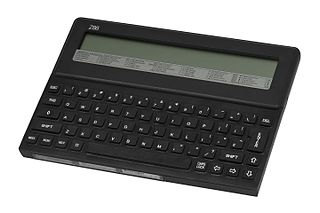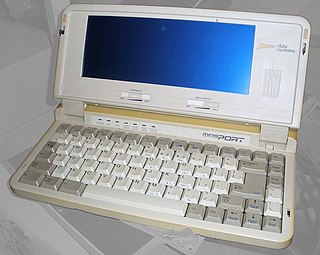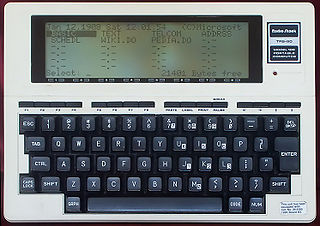Related Research Articles

The Dragon 32 and Dragon 64 are home computers that were built in the 1980s. The Dragons are very similar to the TRS-80 Color Computer, and were produced for the European market by Dragon Data, Ltd., initially in Swansea, Wales, before moving to Port Talbot, Wales, and by Eurohard S.A. in Casar de Cáceres, Spain, and for the US market by Tano Corporation of New Orleans, Louisiana. The model numbers reflect the primary difference between the two machines, which have 32 and 64 kilobytes of RAM, respectively.

The Jupiter Ace by Jupiter Cantab was a British home computer released in 1982. The Ace differed from other microcomputers of the time in that its programming environment used Forth instead of the more popular BASIC. This difference, along with limited available software and poor character based graphic display, limited sales and the machine was not a success.
Psion Organiser was the brand name of a range of pocket computers developed by the British company Psion in the 1980s. The Organiser I and Organiser II had a characteristic hard plastic sliding cover protecting a 6×6 keypad instead of a computer keyboard, with letters arranged alphabetically.
A RAM drive is a block of random-access memory that a computer's software is treating as if the memory were a disk drive. RAM drives provide high-performance temporary storage for demanding tasks and protect non-volatile storage devices from wearing down, since RAM is not prone to wear from writing, unlike non-volatile flash memory.

The Cambridge Z88 is a Z80-based notebook computer released in 1987 by Cambridge Computer, the company formed for this purpose by Clive Sinclair. It was approximately A4 paper sized and lightweight at 0.9 kg (2.0 lb), running on four AA batteries for 20 hours of use.

The Zenith MinisPort is a subnotebook based on an 80C88 CMOS CPU running at two software selectable speeds: 4.77 MHz or 8 MHz. It was released in 1989 by Zenith Data Systems (ZDS).

The TRS-80 Model 100 is a notebook-sized portable computer introduced in April 1983. It was the first commercially successful notebook computer, as well as one of the first notebook computers ever released. It features a keyboard and liquid-crystal display, in a battery-powered package roughly the size and shape of a notepad or large book. The 224-page, spiral-bound User Manual is nearly the same size as the computer itself.
The Acorn Communicator is a discontinued business computer developed by Acorn Computers. Mentioned in the computing press in late 1984 as the C30, previewed in early 1985 with estimated pricing between £500 and £800, in late 1985 with a built-in LCD display, and subsequently unveiled in a slightly different form, the system sold in very low numbers to companies requiring a computer with a built-in modem.

Sleep mode is a low power mode for electronic devices such as computers, televisions, and remote controlled devices. These modes save significantly on electrical consumption compared to leaving a device fully on and, upon resume, allow the user to avoid having to reissue instructions or to wait for a machine to boot. Many devices signify this power mode with a pulsed or red colored LED power light.
A system monitor is a hardware or software component used to monitor system resources and performance in a computer system.
HyperDrive (HD) is a series of RAM-based solid-state drives invented by Accelerated Logic B.V. employee Pascal Bancsi, who partnered with the British company HyperOs Systems, who manufactured the retail product. The HyperDrive interfaces with and is recognized by computer systems as a standard hard drive.

The UltraLite is a line of notebook-sized laptops first released by NEC in 1988. The original model was released in October 1988, alongside the heavier and more-capable ProSpeed. The UltraLite was the first notebook computer on the market compatible with the IBM PC. The original model was based on the NEC V30 microprocessor; the computer includes MS-DOS 3.3 built into ROM.

The PowerBook 170 is a laptop computer that was released by Apple Inc. in 1991 along with the PowerBook 100 and the PowerBook 140. Identical in form factor to the 140, it was the high end of the original PowerBook line featuring a faster 25 MHz Motorola 68030 processor with 68882 floating point unit (FPU) and a more expensive and significantly better quality 9.8 in (250 mm) active matrix display. It was replaced by the PowerBook 180 in 1992.

The Toshiba T1200 is a discontinued laptop that was manufactured by the Toshiba Corporation, first made in 1987. It is an upgraded version of the Toshiba T1100 Plus.

The OLPC XO is a low cost laptop computer intended to be distributed to children in developing countries around the world, to provide them with access to knowledge, and opportunities to "explore, experiment and express themselves". The XO was developed by Nicholas Negroponte, a co-founder of MIT's Media Lab, and designed by Yves Behar's Fuseproject company. The laptop is manufactured by Quanta Computer and developed by One Laptop per Child (OLPC), a non-profit 501(c)(3) organization.

The Amiga 1200, or A1200, is a personal computer in the Amiga computer family released by Commodore International, aimed at the home computer market. It was launched on October 21, 1992, at a base price of £399 in the United Kingdom and $599 in the United States.

The Gdium is a subnotebook / netbook computer produced by EMTEC. The Gdium product is distinguished by its unique Loongson MIPS processor and the use of a USB key as a primary storage device. The Gdium netbook is marketed as an interface device to the Gdium "learning community"—a website that provides hardware support, MIPS builds of open-source software, Linux computing tips, and educational resources targeted towards teachers and students within the K-12 demographic.

Computer hardware includes the physical parts of a computer, such as the central processing unit (CPU), random access memory (RAM), motherboard, computer data storage, graphics card, sound card, and computer case. It includes external devices such as a monitor, mouse, keyboard, and speakers.
This glossary of computer hardware terms is a list of definitions of terms and concepts related to computer hardware, i.e. the physical and structural components of computers, architectural issues, and peripheral devices.
S5/8 was a serial communications standard devised in the United Kingdom in the 1980s as a simplified subset of RS-232 intended to make interoperability easier. Although published by the British Standards Institution as standard DD 153:1990, it was not widely adopted, and the BSI standard was later withdrawn.
References
- ↑ Photo:Dragoneers, ...Taken sometime in 1984 when part of the Dragon team had moved on to Thorn EMI to create the Liberator hand-held computer...Left to Right - Duncan Smeed (original Dragon ROM BIOS developer and head of software), Jan Wojna (worked on Dragon hardware), John Linney (worked on Dragon system software), John Peacock (finance), Derek Williams (Managing Director)...
- ↑ Retro Review: Thorn EMI Liberator (1985) TechTonic
- Smith, Tony (12 November 2012). "Liberator: the untold story of the first British laptop (part 1)". The Register . Retrieved 28 January 2013.
- Smith, Tony (14 November 2012). "Liberator: the untold story of the first British laptop (part 2)". The Register . Retrieved 28 January 2013.
- Smith, Tony (16 November 2012). "Liberator: the untold story of the first British laptop (part 3)". The Register . Retrieved 28 January 2013.